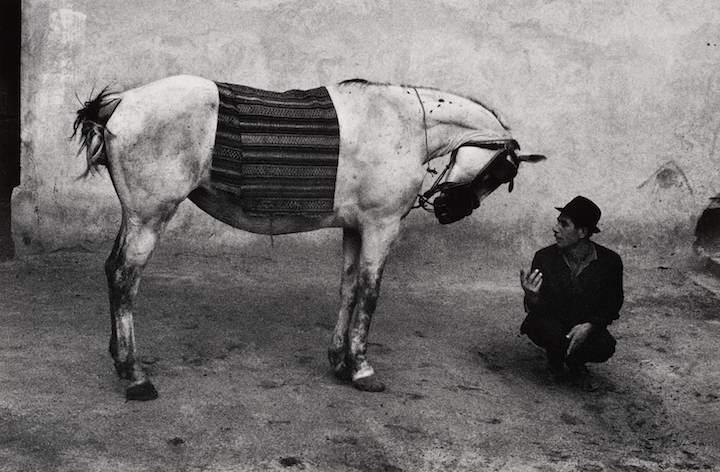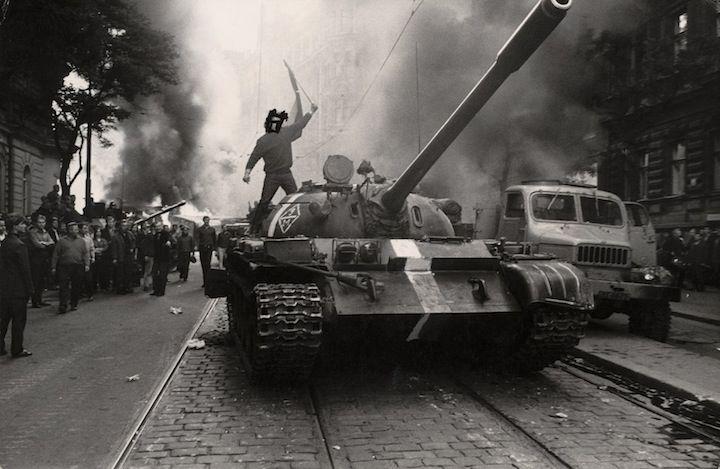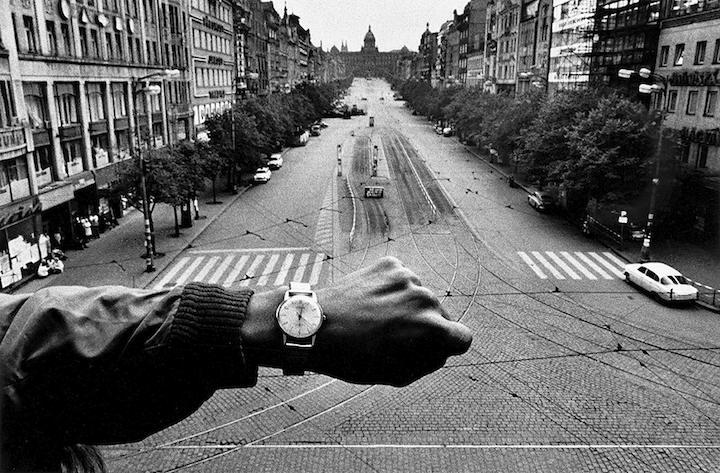Josef Koudelka: Nationality Doubtful
Listen, I have never had any hero in my life or in photography. I just travel, I look and everything influences me…. For 40 years I have been traveling. I never stay in one country
more than three months. Why? Because I was interested in seeing, and if I stay longer I become blind.
—Josef Koudelka
The Czech photographer Josef Koudelka (b. 1938) perhaps invented the road trip as a way of life. Trained as an aeronautical engineer, he took up photography as an interest; after several years of working with a Prague theater group, he quit his job and made photography his life’s work. Starting in 1961 he lived for weeks at a time with the Roma of Czechoslovakia, in their villages, and later with other groups across Europe. This body of work, titled Gypsies, was published in 1975.
The freedom of traveling light and living lean gave Koudelka a tremendous advantage. Always scraping to get his hands on his next few rolls of film caused him to use his eyes—and all of his senses—before snapping the shutter. The freedom he derived from being the sole director of his work took hold, forming his independence and way of life.
 Romania,
from the series Gypsies, 1968, printed 1980s. The Art Institute of Chicago, promised gift of Robin and Sandy Stuart. © JosefKoudelka/Magnum Photos. Courtesy of
Pace/MacGill Gallery, New York.
Romania,
from the series Gypsies, 1968, printed 1980s. The Art Institute of Chicago, promised gift of Robin and Sandy Stuart. © JosefKoudelka/Magnum Photos. Courtesy of
Pace/MacGill Gallery, New York.
“When I first started to take photographs in Czechoslovakia, I met this old gentleman, this old photographer, who told me a few practical things,” he told James Estrin of LensBlog last year. “One of the things he said was, 'Josef, a photographer works on the subject, but the subject works on the photographer.' I have the camera’s viewfinder and I am trying to put the world — for the world — in the viewfinder. But in the same time the world is forming me.”
When the Prague Spring collapsed under Soviet oppression and finally gave way to the invasion in 1968, Koudelka was among several photographers who shot the oncoming tanks. As he was known as the one who shot the most film, he kept his work anonymous, to protect his family from reprisals, and had the negatives smuggled out to Magnum Photos, in London. In one week, he took over 5,000 photographs in the streets of Prague, under extremely difficult and dangerous conditions.
On seeing his images published in the Sunday Times magazine the following year, during a trip to London, Koudelka knew it was time to permanently leave his homeland. He contacted Magnum and received a letter stating that the agency would sponsor his work photographing gypsies across Europe. Later that year his invasion photographs were awarded the Robert Capa Gold Medal Award by the Overseas Press Club, attributed to “an unknown Czech photographer.” When his visa expired in 1970, he remained in London and applied for political asylum.

Student on tank, eyes crossed out, from the series Invasion, 1968. Image
courtesy of the Art Institute of Chicago, promised gift of a private collector. © Josef Koudelka/Magnum Photos.
So began Koudelka’s self-imposed exile. He became a member of Magnum, and subsisted on small grants and awards, shooting in the summer and working on his negatives and prints during the winter. By 1975, his work with the gypsies was finished; the book was produced and published by Robert Delpire that year, alongside an exhibition of the photographs at New York’s Museum of Modern Art.
Koudelka's exile and nomadic way of life became the nexus of his work. From the Roma, perpetual outsiders shunted to society's margins through the Westernization of Central Europe, to his 1988 book, Exiles, in which a powerful sense of estrangement among people in Spain, Ireland, Great Britain and France as well as Romania and Czechoslovakia seems locked together with landscapes from the past, and his own statelessness. In an image where a group of men are setting off fireworks at a festival, the surreal graveness and formality of the scene subsumes any joyousness the occasion might inspire, creating a metaphor for Koudelka's choice.
Since the late 1980s Koudelka has made panoramic landscape photographs in areas massively defiled by industry (Black Triangle, 1994), territorial conflict (Chaos: Beirut, Lebanon, 1991), and most recently, Israel (Wall: Israeli and Palestinian Landscapes, 2013). Images from his series on Greek and Roman archeological are currently on view at Pace Gallery, Chelsea. Information.

Prague, Negative, 1968. Image courtesy of and © Josef Koudelka/Magnum
Photos.
When the monograph Koudelka (2006) was published, Geoff Dyer wrote in The Guardian, "Koudelka's pictures of Gypsies and exiles are in a recognisable documentary tradition, traceable back to André Kertész, but they have such a distinctive, primal quality as to make the idea of precedents seem absurd. His landscapes look like they have not so much been taken as dug from the soil that they frame. Likewise, the moments he depicts may be fleeting, but there is always a deeper intransigence about them. Far from being timeless (as is sometimes claimed), they are saturated in time. Especially the panoramic images of unpeopled space. The impression of stubbornness - a quality shared by the people and places he photographs - is confirmed rather than contradicted by Koudelka's claim that he is 'drawn to what is ending, to what will soon no longer exist.' The panoramas make the world look like a place where, against all odds, human life thrived - but only briefly."
Next week the first retrospective of Koudelka's work in the United States since 1988 opens at The Art Institute of Chicago. The exhibition draws on the photographer's extensive holdings of his own work and on recent major acquisitions by the Art Institute, including the complete surviving contents of the debut presentation of Gypsies in 1967 (22 photographs), as well as ten Invasion images printed by the photographer just weeks after the event. Also on display are early experimental and theater photographs and some of the photographer’s beautifully produced accordion books—which stretch dozens of feet when unfolded.
Josef Koudelka | Nationality Doubtful continues through March 22 at the J. Paul Getty Museum, 1200 Getty Center Drive, Los Angeles. Information.


